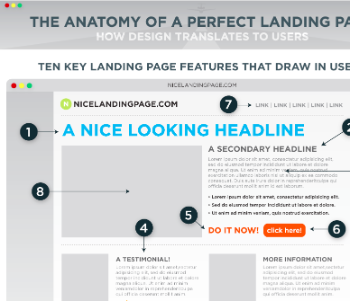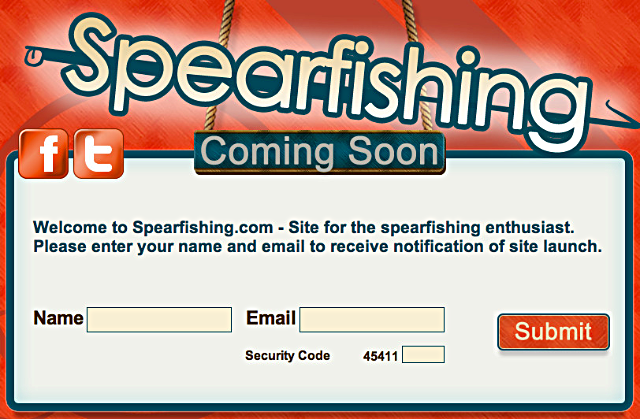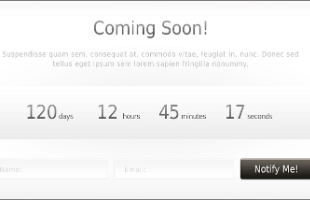Domain parking is not the only alternative to full web development. There are many ways to monetize, utilize and grow your web traffic without taking the expensive, long road of full web development.
I believe it was Rick Schwartz who asked: What is the value of a click if that click leads to the sale of an airplane? He was referring to affiliate sales versus pay-per-click campaigns, but his point is well taken. By understanding your domain name market, you can generate greater revenue than from just parking, even if your site – or your pocketbook – is not ready for full-scale development.
Minisites
It took me awhile to accept the concept of minisites. As a matter of fact, I dislike the term, but what it describes is a site with a few pages of content designed mainly to capture search engine traffic while waiting on full-scale development. I do something similar with my own domains to avoid blockage for being a parked name.

Some people leave their domains as minisites. Others use it as a testing tool before they develop full scale. Either way, make sure your domain name is a good candidate for a content-only site. That is, it should be a site for which the core audience would be seeking information only, such as CareerGuide.com or AllAboutCats.com. Less ideal candidates for minisites are geodomains, such as MiamiFlorida.com, which need to provide more than just a few pages of content for their audience of residents and tourists; and domains that are better off as lead generation sites, such as USADentists.com.
Use content that has been uniquely written for your website. Target keyword terms that relate to your domain name and use data capturing methods such as an opt-in newsletter subscription that can be used down the road for activities such as marketing, relationship development, lead generation and sales prospects.
Landing Pages
 A landing page is single web page that users arrive at after following a link, often in an advertisement. Landing pages are designed for several purposes: to collect leads, to advertise affiliate products, or to serve as a tailored destination for ad campaigns and targeted search engine traffic.
A landing page is single web page that users arrive at after following a link, often in an advertisement. Landing pages are designed for several purposes: to collect leads, to advertise affiliate products, or to serve as a tailored destination for ad campaigns and targeted search engine traffic.
Landing pages are also useful for experimenting with traffic before moving to full-scale web development. I like niche landing pages that promote other established sites that do well at long tail SEO.
As with minisites, make sure the content of your landing page is unique and sufficient enough to hold its own, and use data capturing methods such as an opt-in newsletter subscription to gather user information for future use. It is also a good idea to include social media methods, such as links to Twitter and Facebook pages, to further build an audience for when you decide to develop full scale.
“Under Construction” Web Pages
It is not 1999 anymore, but “under construction” web pages can still serve a useful pre-development purpose. My favorite method is to display a logo, a newsletter sign-in box, links to relevant social accounts and a medium-sized paragraph promoting the site. This provides a bit of marketing collateral and allows you to capture an audience, all before site launch and the real marketing begins.


Domain Leasing
If you have a domain name that receives a decent amount of type-in traffic, domain leasing might be for you. Domain leasing allows other individuals or businesses to display content and advertising, usually exclusively, on your domain for a fee. Left of the Dot Media is the latest company in this area who provides these services; it develops eCommerce and business sites on the sub-directories of premium domains. Other domain leasing providers are LeaseThis.com and Root Orange.
If you take domain leasing into your own hands, be sure to factor in the loss of revenue while your domain is leased out when determining a fair monthly fee. Also consider including an optional buy-out price in case the company wants to take ownership of the domain name.
Site Clone Scripts
Sometimes you want to get a good feel for how a domain might perform if it was developed, let’s say as a social networking site versus a wiki site. Thanks to sites such as ScriptCopy.com that offer site clone scripts, you can.
With site clone scripts, you can design a site that looks and functions like an existing popular website. Most site scripts work fresh from install and need only a few configurations. This will help you gauge what type of development is best for your domain. From there you can either build off the clone script or start over from scratch.
Affiliate Sites and Scripts
Another approach to monetizing type-in-traffic domains is to use the ready-made solutions provided by top affiliates (such as Amazon and eBay) to get an idea of who is buying and clicking what. Having a better feel for what your target audience is looking for will help you plan content.
Related Cheat Sheets
For Further Reading
- Wikipedia: Landing Pages
- CopyBlogger.com: Landing Pages Turn Traffic into Money
- Digital-Web.com: 11 Ways to Improve Landing Pages
- TiaWood.com: The New Under Construction Page
[Image credits: Vintage Wines Minisite, Formstack: Anatomy of a Landing Page, Spearfishing.com Under Construction, Webtreatsetc Countdown Under Construction]
If you enjoyed this article, subscribe for updates (it's free)
 Be Interviewed on DomainSherpa
Be Interviewed on DomainSherpa


















Originally trying to solve the riddle “how to get traffic and revenue to domains with languages too small to generate seriuous type-in traffic” (which bascially means any language than English :-) we built a platform to do something better than domain parking and something faster to set up than any minisite service. We’re currently running about 1000 of our own domains off of this platform and several 1000s for pilot partners.
What we find is that if you can spend less than 10 minutes setting up a minisite that’s not a whole lot more than what you’re spending setting up a proper parking page for your domain in GoDaddy or Sedo anyway. The resulting difference is huge, though. Most minisites will need in-links unless you find a niche completely without SEO competition so ranking for your domain name is usually out of the question unless you turn to blackhatting (which basically means cheating and cannot be considered a sustainanable strategy for domain development).
Note that the kind of minisites we ended up making are not the ususal “12 page, WordPress, original content written on SEO steroids, with just one outlink to an affiliate ad/site”. The sites we set up are in principle niche news agents searching selected news sites every day with a proprItary news agent. Instead of setting up keywords to define parking ads (as you would with a parking page) your keywords are actually defining what the news agent should look for. If done right, all your articles will be thematically relevant as the site will be a pinpointed source for research about the topic you have defined for your domain. Over time our sites will therefore not really be minisites but self-updating news sites for a niche topic, often with hundreds or sometimes thousands of pages. This again means you site will tap into the “long tail” of searches done in search engines.
This concept seems to be working well. We’re monitoring above all the kind of keywords people use in search engines before clicking through to our sites and 95% are typically spot on the niche theme. Also, our numbers are not bad (at least we’re happy with them). We’re mostly using AdSense which is reporting these average numbers: More than 3% CTR (that means 3 or more out of 100 visitors click on our ads), eCPM of more than $20, total revenue of more than $30 per domain per year.
What we found is that you don’t need monster traffic to make a profit with almost any domain, what you need is long tail traffic that is thematically on-target to a site which provides both a useful service and useful ads. And if you do this, your domain will also become more valuable when you sell it since it has a thematically meaningful history with search engines.
What we wanted to do for ourselves was first of all to create kind of minisite that would allow us to at least make enough revenue to cover the yearly fee. Secondly we wanted to understand as quickly as possible which domains in our portfolio could be worth devleoping into bigger sites. Then we got in touch with other domainers who asked to use our system, so now we’re a start-up trying to do for other domainers what we did for ourselves.
I agree totally, having created 1500+ minisites over the last 7 years.
Although I never developed or used any of these alternatives for a website, I have much respect for anyone that can. Development is a skill set that I wish I had!…my ADD only allows me to buy and sell.
Another options is to create a WP blog.
Hi Tia,
Thanks for writing this. It is great to help people realize that there are alternatives to parking or development outright. However, I should clarify that our approach at Left of the Dot is not your standard leasing in the way that LeaseThis operates. We partner with the domain holder to build out their asset (in what should be called a full site development). As part of our build out, we then lease of sub-domains to small businesses interested in the brandability of the sub-domain, its inherent SEO value, or the ability to use it in marketing campaigns to boost click thru rates. A few examples of recently deployed Marketing Names (as we call our sub-domains) include: http://Ireland.Importers.com or http://Tours.Oahu.com.
In any case, good names should have something done with them, and ourselves and others can definitely help Domainers make the most of their assets.
Very useful article. Thanks, Tia.
When you wrote “If you have a domain name that receives a decent amount of type-in traffic, domain leasing might be for you.” How much type-in traffic do you think a domain name needs to have for people to consider leasing it?
Good question, Tony. Although there isn’t an exact number range to determine what constitutes as “good type-in traffic” it really depends on the domain and if that traffic is converting. How to test this is by reviewing the click through rates when parking or see how much traffic converts to leads if not parking. Any data like this that you compile can be used to show the domain’s marketability when leasing the domain.
A few hundred unique visits per day may or may not do it. Again, it depends on the domain, how commercial that domain is and if the audience is convertible so doing a small series of tests will help you determine if the domain is a good candidate for leasing.